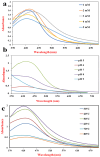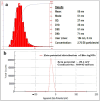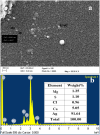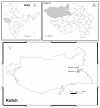Exploring the Potential of Halotolerant Actinomycetes from Rann of Kutch, India: A Study on the Synthesis, Characterization, and Biomedical Applications of Silver Nanoparticles
- PMID: 38931410
- PMCID: PMC11206697
- DOI: 10.3390/ph17060743
Exploring the Potential of Halotolerant Actinomycetes from Rann of Kutch, India: A Study on the Synthesis, Characterization, and Biomedical Applications of Silver Nanoparticles
Abstract
A tremendous increase in the green synthesis of metallic nanoparticles has been noticed in the last decades, which is due to their unique properties at the nano dimension. The present research work deals with synthesis mediated by the actinomycete Streptomyces tendae of silver nanoparticles (AgNPs), isolated from Little and Greater Rann of Kutch, India. The confirmation of the formation of AgNPs by the actinomycetes was carried out by using a UV-Vis spectrophotometer where an absorbance peak was obtained at 420 nm. The X-ray diffraction pattern demonstrated five characteristic diffraction peaks indexed at the lattice plane (111), (200), (231), (222), and (220). Fourier transform infrared showed typical bands at 531 to 1635, 2111, and 3328 cm-1. Scanning electron microscopy shows that the spherical-shaped AgNPs particles have diameters in the range of 40 to 90 nm. The particle size analysis displayed the mean particle size of AgNPs in aqueous medium, which was about 55 nm (±27 nm), bearing a negative charge on their surfaces. The potential of the S. tendae-mediated synthesized AgNPs was evaluated for their antimicrobial, anti-methicillin-resistant Staphylococcus aureus (MRSA), anti-biofilm, and anti-oxidant activity. The maximum inhibitory effect was observed against Pseudomonas aeruginosa at (8 µg/mL), followed by Escherichia coli and Aspergillus niger at (32 µg/mL), and against Candida albicans (64 µg/mL), whereas Bacillus subtilis (128 µg/mL) and Staphylococcus aureus (256 µg/mL) were much less sensitive to AgNPs. The biosynthesized AgNPs displayed activity against MRSA, and the free radical scavenging activity was observed with an increase in the dosage of AgNPs from 25 to 200 µg/mL. AgNPs in combination with ampicillin displayed inhibition of the development of biofilm in Pseudomonas aeruginosa and Streptococcus pneumoniae at 98% and 83%, respectively. AgNPs were also successfully coated on the surface of cotton to prepare antimicrobial surgical cotton, which demonstrated inhibitory action against Bacillus subtilis (15 mm) and Escherichia coli (12 mm). The present research integrates microbiology, nanotechnology, and biomedical science to formulate environmentally friendly antimicrobial materials using halotolerant actinomycetes, evolving green nanotechnology in the biomedical field. Moreover, this study broadens the understanding of halotolerant actinomycetes and their potential and opens possibilities for formulating new antimicrobial products and therapies.
Keywords: Rann of Kutch; actinomycete; halotolerant; multidrug resistance; silver nanoparticles.
Conflict of interest statement
The authors declare no conflict of interest associated with the publication of this article.
Figures











Similar articles
-
Synthesis, characterization and evaluation of antimicrobial and cytotoxic activities of biogenic silver nanoparticles synthesized from Streptomyces xinghaiensis OF1 strain.World J Microbiol Biotechnol. 2018 Jan 5;34(2):23. doi: 10.1007/s11274-017-2406-3. World J Microbiol Biotechnol. 2018. PMID: 29305718 Free PMC article.
-
Green Synthesis of Silver Nanoparticles from Allium cepa L. Peel Extract, Their Antioxidant, Antipathogenic, and Anticholinesterase Activity.Molecules. 2023 Mar 2;28(5):2310. doi: 10.3390/molecules28052310. Molecules. 2023. PMID: 36903556 Free PMC article.
-
Inhibition of microbial growth by silver nanoparticles synthesized from Fraxinus xanthoxyloides leaf extract.J Appl Microbiol. 2021 Jul;131(1):124-134. doi: 10.1111/jam.14944. Epub 2020 Dec 15. J Appl Microbiol. 2021. PMID: 33251642
-
Exploring the diversity and antimicrobial potential of actinomycetes isolated from different environments in Saudi Arabia: a systematic review.Front Microbiol. 2025 Mar 26;16:1568899. doi: 10.3389/fmicb.2025.1568899. eCollection 2025. Front Microbiol. 2025. PMID: 40207161 Free PMC article. Review.
-
Advancing biomedical applications: an in-depth analysis of silver nanoparticles in antimicrobial, anticancer, and wound healing roles.Front Pharmacol. 2024 Aug 8;15:1438227. doi: 10.3389/fphar.2024.1438227. eCollection 2024. Front Pharmacol. 2024. PMID: 39175537 Free PMC article. Review.
Cited by
-
Multifunctional Silver Nanoparticles Synthesized via Exiguobacterium aurantiacum: Applications in Dye Remediation, Anticancer and Antibacterial Activity.Curr Microbiol. 2025 May 15;82(7):289. doi: 10.1007/s00284-025-04259-1. Curr Microbiol. 2025. PMID: 40372469
-
Impeding Biofilm-Forming Mediated Methicillin-Resistant Staphylococcus aureus and Virulence Genes Using a Biosynthesized Silver Nanoparticles-Antibiotic Combination.Biomolecules. 2025 Feb 11;15(2):266. doi: 10.3390/biom15020266. Biomolecules. 2025. PMID: 40001569 Free PMC article.
-
Tackling carbapenem-resistant Acinetobacter baumannii (CRAB) and their virulence factors using biosynthesized silver nanoparticles combined with imipenem.Biotechnol Notes. 2025 Jul 19;6:183-195. doi: 10.1016/j.biotno.2025.07.002. eCollection 2025. Biotechnol Notes. 2025. PMID: 40808995 Free PMC article.
-
Recent advances in nanotechnology for Parkinson's disease: diagnosis, treatment, and future perspectives.Front Med (Lausanne). 2025 Jan 22;12:1535682. doi: 10.3389/fmed.2025.1535682. eCollection 2025. Front Med (Lausanne). 2025. PMID: 39911864 Free PMC article. Review.
References
-
- Subathra Devi C., Merlyn Keziah S., Jemimah Naine S., Mohanasrinivasan V. Actinobacteria. Springer; Singapore: 2022. Actinomycetes: Microbiology to Systems Biology; pp. 1–35.
LinkOut - more resources
Full Text Sources

